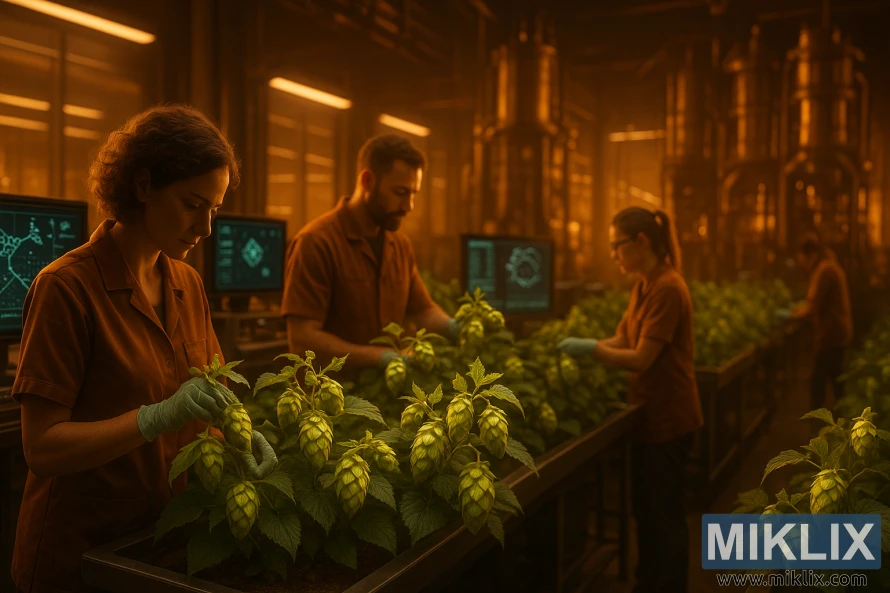Image: Willamette Valley Hop Farm
Published: August 4, 2025 at 4:51:51 PM UTC
Last updated: September 27, 2025 at 9:55:18 AM UTC
A sustainable hop farm in Oregon’s Willamette Valley with trellised bines, farmers at work, and rolling hills, highlighting eco-friendly hop cultivation.
The image presents a vision of hop cultivation reimagined through the lens of advanced science and technology, where age-old traditions of brewing intersect with the precision of modern innovation. Bathed in a warm amber glow, the laboratory seems to merge the organic vitality of living plants with the sleek efficiency of futuristic machinery. In the foreground, technicians work with a quiet intensity, their hands sheathed in protective gloves as they carefully examine clusters of hop cones. Each cone, vibrant with layered bracts and glistening lupulin glands, is handled with the same attentiveness that farmers once applied in the fields. Yet here, the environment is meticulously controlled, with every variable—light, temperature, humidity, and nutrient balance—calibrated to maximize the plants’ potential. The juxtaposition of living greenery against the structured sterility of the lab conveys a striking sense of continuity between tradition and progress.
The middle ground of the scene brings into focus the analytical heart of this futuristic facility. Rows of monitors line the benches, their displays filled with intricate diagrams, molecular renderings, and genetic profiles that reveal the unseen inner workings of the hop plants. These visualizations map the biochemical pathways that give rise to the oils and resins responsible for the unmistakable flavors and aromas found in beer—notes of citrus, pine, spice, and tropical fruit distilled into data streams of colored graphs and shifting molecular models. Technicians consult these readouts as they tend the plants, blending empirical observation with computational insight, ensuring that every adjustment made to the environment or breeding process aligns with precise goals. It is a choreography of science and craft, where instinct and technology work in unison.
Further back, the scale of the operation expands into a panorama of industrial sophistication. Towering stainless steel structures loom in the background, automated systems humming as they prepare for the next phase of processing. Conveyor belts, sealed chambers, and extraction columns form a continuous chain designed to distill and refine the delicate hop oils into their purest form. Steam and faint wisps of vapor rise in the ambient light, signaling the constant transformation occurring within these machines. Unlike the rustic barns and drying kilns of traditional hop farms, these modern facilities reflect a new chapter in brewing, where efficiency and precision can unlock flavors and characteristics once thought unattainable.
The atmosphere of the entire scene radiates a sense of reverence—despite the sterile environment and futuristic equipment, there is a profound respect for the natural plant at the heart of it all. The technicians move with purpose and patience, their attention to detail suggesting not just scientific inquiry, but genuine admiration for the hops themselves. The amber-hued lighting, reminiscent of the color of beer itself, creates an almost ceremonial aura, as if the entire space were a cathedral to brewing innovation. Here, science does not replace tradition, but builds upon it, seeking to understand and enhance what centuries of farmers and brewers have cherished.
Together, these layers create an image of a brewing future rooted in the past but propelled forward by discovery. The lush rows of hop plants speak to the continuity of cultivation, the glowing screens symbolize knowledge unlocked at the molecular level, and the towering machinery suggests a future where artisanal flavor meets industrial capability. It is a world where hops are no longer just grown—they are engineered, nurtured, and perfected with a precision that ensures their role in brewing will continue to evolve, inspiring new generations of beer and new dimensions of flavor.
The image is related to: Hops in Beer Brewing: Willamette

